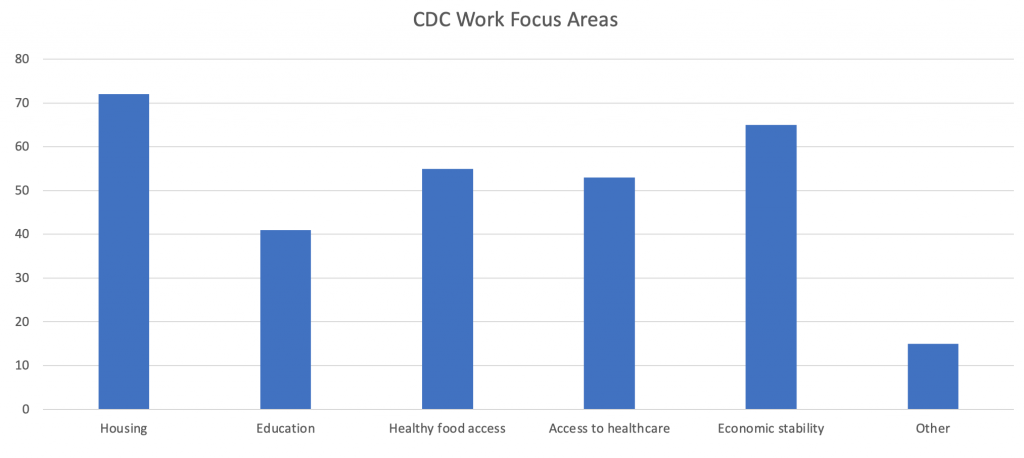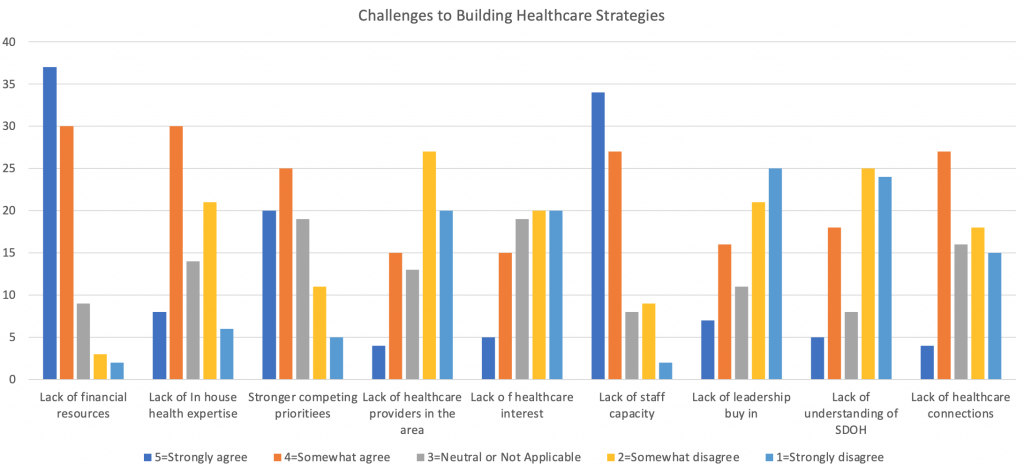Post From Our Publications and Reports
During this survey process, we heard from 119 CDCs across 30 states, spanning geography and urban and rural communities. We learned that while many CDCs who answered the survey are already engaging with healthcare, many need additional capacity (knowledge, staff, and resources) to sustain healthcare engagement efforts. We also found that many are still at the beginning of their journey toward healthcare engagement.
Here we provide the history and context of this effort, describe what we learned, and discuss how we will continue to support CDCs in their local work to advance racial equity, reduce poverty, and improve health.
Context
With funding from The Kresge Foundation, we launched Community Innovations, a program with a three pronged goal: to enhance the Network’s understanding of how best to support local organizations’ cross-sector efforts; to connect local organizations to other peer organizations and the larger national dialogue, resources, and tools; and to embed capacity within organizations to undertake health strategies and engage with healthcare.
As a way to help inform the Community Innovation’s proposal process, we worked with our partners’ organizations who share our vision and Community Innovation Advisors to disseminate the survey to a large audience.
We received 119 responses to the survey from CDCs across 30 states. These CDCs focus on a range of efforts that span the social determinants of health (SDOH), including housing, education, healthy food access, economic stability, and others (see figure 1).

Figure 1: CDCs’ areas of focus (click to enlarge)
CDCs already see the health value of their work

Figure 2: CDCs’ challenges to building strategies for engaging healthcare (click to enlarge)
CDCs want additional support engaging healthcare
Importantly, this survey took place in January, 2020 prior to the murder of George Floyd, Breonna Taylor, and other African Americans that were killed due to police violence, and the national spotlight and ensuing rise in racial justice work. We would not be surprised to see a shift in responses if we were to resurvey these CDCs at the end of 2020.

Figure 3: Support CDCs’ need to engage with healthcare organizations (click to enlarge)
Figure 4: Helpful tools and resources for CDCs to engage healthcare organizations
Summary
Based on the survey results, the Network has continued tailoring resources to meet the needs expressed. In addition, we are actively providing technical support and resources to five CDCs as part of the Community Innovations award program. Further, we are exploring ways to provide additional capacity building to the broader CDC field in order to support their local healthcare engagement efforts. This survey has helped us better understand the CDC landscape and BHPN’s role at the intersection of community development, health, and finance sectors. This survey shows that CDCs already inclined toward cross-sector collaboration – both early adopters and those with interest – are considering the health value of their work, interested in developing healthcare partnerships, and need additional knowledge building and capacity to engage with healthcare.
The Build Healthy Places Network works to be the go-to resource for these CDCs in support of a common vision: communities where all people can live rewarding and healthy lives.